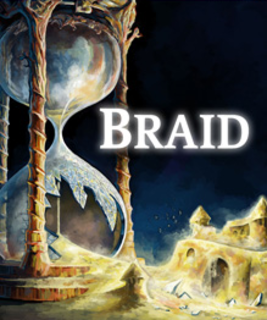In order for a work of art to be pretentious, it has to have zero impact on the world it wishes to affect.
He is, despite the superciliousness of either side, without blame. An opinion is the product of a person's environment. We enjoy the games that we enjoy because we can connect the experience to some person, object, or time in our lives when everything was all good, or all bad, or both. That means that some will enjoy Braid and others won't. That doesn't make any one side more "enlightened" then the other, for "enlightenment" has little to do with opinion--much less our opinions of a videogame. Though, that doesn't mean that this game cannot "enlighten" the player or expand their mind.
Braid is a challenging game. The worlds share between them, the same ability to rewind time; however, each world has its own identity by, having built on top, a new mechanic that changes the way the player has to think. In World 5, for instance, the player deals heavily with corresponding, but parallel universes. Your character, when rewound, will have a parallel version of himself execute the timeline previous to the moment you rewound time. It is complex, surely, but not alienating. The game is purely about hypothesizing and puzzle solving, and any attempt to explain it will surely end in a pretentious pile of paragraphs.
The story, though vague, isn't impossible to understand. The beauty of vagueness, in the case of Braid, is that it allows the player to fill in the blanks themselves. It isn't completely ad-lib; however, because much of the story relies on metaphors. Whats more unfortunate is that I cannot possibly explain the story without diluting the revelation at the end of the game. In a sense; however, the game explores, in part, the nature and condition of man.
The look and aesthetic of the game is, according to any screenshot, not at all interesting. The difference between playing and looking at the game is, notwithstanding, a completely different experience. Much of the beauty of Braid comes from it's motion--from the subtle panning of the background to the smooth animation of the goombas. Even if someone doesn't like the current aesthetic, and I can't imagine them enjoying the older aesthetic.
Puzzles, in this game, are very challenging. They force you to first experiment, then hypothesize, then plan how you are going to solve each puzzle. Very few of them require any sort of trial and error if you can work through the problem methodically. The difficultly of the puzzles; however, should not be a critique of the game. If a game is not challenging, then the player is not thinking. If the player is not thinking, they are not learning. And if the player isn't learning then is there any point to the challenge in the first place?
Blow created this game as a statement to the dev. world. You see, in a speech of his entitled "Design Reboot" at a toronto indie dev. fest, he argued that many game devs seek to exploit the player. Nick Yee calls it the "Virtual Skinner Box". The tactic is simply to reward the player at indefinite moments in time to keep them playing instead of actively challenging the player with a puzzle or an enemy with thoughtful attack patterns--which can also be described as an open-ended puzzle of sorts.
Anyone remember in The Office when Jim decides to prank Dwight by using the skinner technique? Well, probably not. Essentially, every time Jim plays the windows error sound, he gives Dwight an Altoid. Eventually, every time Dwight hears this sound, he salivates and reaches out for another Altoid. This is quintessentially the Skinner technique. Only, in videogames, it is used to keep the player coming back for more even if they aren't really enjoying the game. Such is the exploitation that Jonathan Blow is trying to avoid with Braid--and it shows. There were no corners cut. In fact, every sprite is different from the next. Every world has an identifiable look and the mechanics are different enough to change the way the player thinks every time.
Braid is a thinking game. In many cases, I was inclined to look up a walkthrough. Even so, the beauty of this game is found in it's complexity. It isn't impossible, but it also isn't meant to be completed in a day. Part of the reason why so many people feel hollow after playing the game is often because they rush through it to reach the end. To those who are tempted, I say: Don't rush. Take your time. Use a walkthrough very sparingly--finally, don't be discouraged. Every piece of each puzzle is placed there for a reason. Every flower, every enemy is there to both hinder and help you progress to the finish. Mark where everything is at a certain point in time and don't be afraid to start the scene over if you must.
Braid isn't pretentious, for it has had a very large impact on the dev. world. It is likely that many of the games you play from now on will include elements inspired by this game. Not everyone will enjoy it, but not everyone needs to. In the end; however, anyone who has any interest in game design ought to study this game thoroughly in attempts to improve their own perspective on game design.

